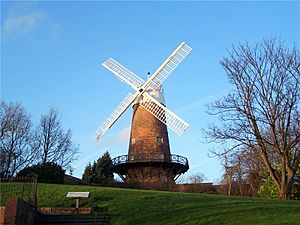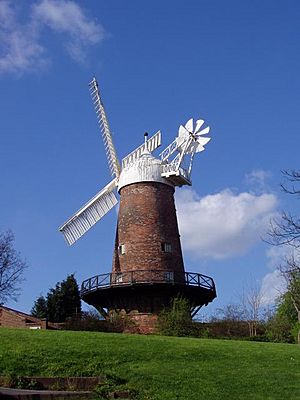Green's Mill, Sneinton facts for kids
Green's Windmill is a historic windmill located in Sneinton, Nottingham, England. It was built in the early 1800s to grind wheat into flour. After being used for many years, it stopped working in the 1860s. Later, in the 1980s, it was carefully repaired and brought back to life. Today, it's a popular place to visit, combined with a science centre, offering a fun way to learn about science and history.
Contents
The Mill's Journey Through Time
This amazing tower mill was built around 1807 by a baker named George Green. It stands where an older wooden mill once was. In 1829, George Green passed away, and his son, a brilliant mathematician named George Green, inherited the mill.
The mill was very busy! Its huge sails, about 12 yards long, spun around 25 times every minute. This made the grinding stones inside turn very fast, grinding a large amount of wheat into flour in just a few hours. The sails could be adjusted to catch the wind perfectly, no matter how strong it was.
George Green ran the mill until he died in 1841. After that, other people rented and operated it. However, by the 1860s, newer steam powered mills became popular. These modern mills were faster and cheaper, so Green's Windmill eventually had to close. Its sails were taken down, and the mill slowly fell apart. The wooden roof rotted, and even the fantail (a small windmill at the back that turns the main cap) broke off!
In 1919, a local lawyer named Oliver Hind bought the mill. He put a copper cap on top in 1923 to keep the rain out. The mill was then used as a factory to make boot polish. Sadly, in 1947, a fire broke out, destroying the roof again. The mill was left in ruins once more.
Bringing the Mill Back to Life
The mill was in very bad shape and almost torn down. But in 1979, Nottingham City Council stepped in to save it. With money raised by the University of Nottingham, the mill was beautifully restored between 1984 and 1986. It was reopened in December 1986.
Today, Green's Windmill is a special place. It's not just a working windmill; it's also part of a science centre. Visitors can see how the mill works and learn about the science behind it. It's a fantastic example of how old buildings can be given new life and used to teach us about the past and present. The mill is a listed building, meaning it's protected for its historical importance.
How the Windmill Works
Green's Mill uses only the wind to power its operations. Here's how it works:
- The large sails on the outside catch the wind.
- As the wind pushes the sails, they spin around.
- This spinning motion turns a big wooden drive shaft inside the mill.
- The drive shaft connects to different machines using gear trains.
- These gears power the millstones and other equipment.
The process of making flour at Green's Mill is fascinating:
See also
- Listed buildings in Nottingham (Dale ward)
External links
- Green's Mill & Science Centre
- A Short Guide to Green’s Mill and How it all Works
- See Green's Mill on Google Street View.











